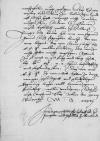Dem durchlauchten, hochgebornen fursten und hernn, hern ⌊Albrechten⌋, von Gots gnaden marggraff zu ⌊Brandenburg⌋, / in ⌊Preussen⌋, zu ⌊Stetin⌋, ⌊Pomernn⌋, der ⌊Kaszuben⌋ und ⌊Wenden⌋ hertzog, / burggraff zu ⌊Normberg⌋ und furst zu ⌊Rugenn⌋, unsermm hochgunstigen, lyben hern und freunde
Durchlauchter, hochgeborner furst, hochgunstiger, lieber her und freundt. / Unsere freuntliche, wyllige dinst zuvoran. /
Wir haben negst Ewer Furstlichen Durchlaucht vilgunstig ⌊⌋, / datumm zu ⌊Iohansburg⌋ den VII dits monds, von unserm dyner erhalten, / doraus wir vormherung furstlicherr gunst gen uns mit danckbarlichem gemuet gerne vorstanden. / Ist unss aber Ewer Furstlichen Durchlaucht leybs swacheit, domit dy uff dass mal befaln, hertzlich leydt gewesen / und Got den almechtigennn gebethen, / der selbtigen Ewer Durchlaucht widerumb wolle vorige gesuntheit zu langen getzeÿten vorleÿhen etc. Es ist uns auch darnach Ewer Durchlaucht ⌊⌋ abermals, datumm den XXIII dits monds, zu komen, / was dÿ grentzen / belanget, / welchs wir den, / dÿ solche grenitz betziehung anghet, / wollen mittheÿlennn / und darnach Ewer Durchlaucht wÿssen lassen, / wan solchs fueglicher weys / noch Ewer Furstlicher Durchlaucht wolgefallen muge geschen, / dobeÿ, so wir unsers bedunckens im ⌊colmischen lande⌋ uff solche zeytt vileicht nicht werden mugen sein, / andren comissarienn unser befellich wollen zcustellen etc.
Pringer dits brives hat uns von seynemm hernnn auch schreyben bracht, / der von uns begert, / das wir seÿnne sache beÿ Ewer Furstlichen Durchlaucht wolden furderen, / das wir im nicht haben mocht vorsagen, / byttendt im, so weÿt er gut fueg und recht hatt, / beÿ ⌊koniglicher maiestet⌋, unser allergnedigsten hernn, / behulfflich und beÿstendig sein, / das wir umb Ewer Furstlichen Durchlaucht, dÿ wir Gott bytten in langweriger gesuntheitt und gluckseligerr regirung lenger wold bewaren, gerne freuntlich wollen vordynen. /


